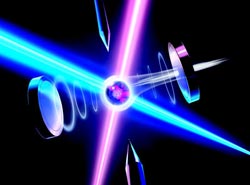Into the quantum internet at the speed of light

The atom’s quantum information is written onto the polarization state of the photon.<br>Graphics: Harald Ritsch<br>
In the current issue of Nature Photonics, a research team of Innsbruck physicists led by Rainer Blatt and Tracy Northup report how they have directly transferred the quantum information stored in an atom onto a particle of light. Such information could then be sent over optical fiber to a distant atom.
Thanks to the strange laws of quantum mechanics, quantum computers would be able to carry out certain computational tasks much faster than conventional computers. Among the most promising technologies for the construction of a quantum computer are systems of single atoms, confined in so-called ion traps and manipulated with lasers. In the laboratory, these systems have already been used to test key building blocks of a future quantum computer. “Currently, we can carry out successful quantum computations with atoms,” explain Andreas Stute and Bernardo Casabone, both PhD students at the University of Innsbruck’s Institute for Experimental Physics. “But we are still missing viable interfaces with which quantum information can be transferred over optical channels from one computer to another.”
What makes the construction of these interfaces especially challenging is that the laws of quantum mechanics don’t allow quantum information to be simply copied. Instead, a future quantum internet – that is, a network of quantum computers linked by optical channels – would have to transfer quantum information onto individual particles of light, known as photons. These photons would then be transported over an optical-fiber link to a distant computing site. Now, for the first time, quantum information has been directly transferred from an atom in an ion trap onto a single photon. The work is reported in the current issue of Nature Photonics by a research team led by Tracy Northup and Rainer Blatt.
Quantum networkers
The University of Innsbruck physicists first trap a single calcium ion in an ion trap and position it between two highly reflective mirrors. “We use a laser to write the desired quantum information onto the electronic states of the atom,” explains Stute. “The atom is then excited with a second laser, and as a result, it emits a photon. At this moment, we write the atom’s quantum information onto the polarization state of the photon, thus mapping it onto the light particle.” The photon is stored between the mirrors until it eventually flies out through one mirror, which is less reflective than the other. “The two mirrors steer the photon in a specific direction, effectively guiding it into an optical fiber,” says Casabone. The quantum information stored in the photon could thus be conveyed over the optical fiber to a distant quantum computer, where the same technique could be applied in reverse to write it back onto an atom.
Support for this research was provided by the Austrian Science Funds and by the European Union.
Publication: Quantum-state transfer from an ion to a photon. A. Stute, B. Casabone, B. Brandstätter, K. Friebe, T. E. Northup, R. Blatt. Nature Photonics 2013 DOI: 10.1038/NPHOTON.2012.358 (http://dx.doi.org/10.1038/NPHOTON.2012.358)
Rückfragehinweis:
Andreas Stute
Institute for Experimental Physics
University of Innsbruck, Austria
Tel.: +43 512 507-52465
E-Mail: andreas.stute@uibk.ac.at
Christian Flatz
Public Relations Office
University of Innsbruck
Tel.: +43 512 507-32022
Mobil: +43 676 872532022
E-Mail: christian.flatz@uibk.ac.at
Media Contact
More Information:
http://www.uibk.ac.atAll latest news from the category: Physics and Astronomy
This area deals with the fundamental laws and building blocks of nature and how they interact, the properties and the behavior of matter, and research into space and time and their structures.
innovations-report provides in-depth reports and articles on subjects such as astrophysics, laser technologies, nuclear, quantum, particle and solid-state physics, nanotechnologies, planetary research and findings (Mars, Venus) and developments related to the Hubble Telescope.
Newest articles

Innovative 3D printed scaffolds offer new hope for bone healing
Researchers at the Institute for Bioengineering of Catalonia have developed novel 3D printed PLA-CaP scaffolds that promote blood vessel formation, ensuring better healing and regeneration of bone tissue. Bone is…

The surprising role of gut infection in Alzheimer’s disease
ASU- and Banner Alzheimer’s Institute-led study implicates link between a common virus and the disease, which travels from the gut to the brain and may be a target for antiviral…

Molecular gardening: New enzymes discovered for protein modification pruning
How deubiquitinases USP53 and USP54 cleave long polyubiquitin chains and how the former is linked to liver disease in children. Deubiquitinases (DUBs) are enzymes used by cells to trim protein…


